What Animals Live On The Galapagos Islands
It's 3 PM, the hot, bright equatorial lord's day still remains high in its descending arch to the western horizon. The wind is calm and the sea polish as our rigid lesser inflatable (aka RBI or panga) commuter Alex, idles the short distance from the Galapagos Aggressor II (GAII) to our entry betoken, a cove near Punta Vicente Roca, on the northeast corner of Isla Isabela.
Armed in 7 mils of blackness neoprene from head to toe, the five defined in our panga are beginning to sweat uncomfortably nether the blazing sun. Richard, our divemaster, is also completely covered in black condom and senses our discomfort.
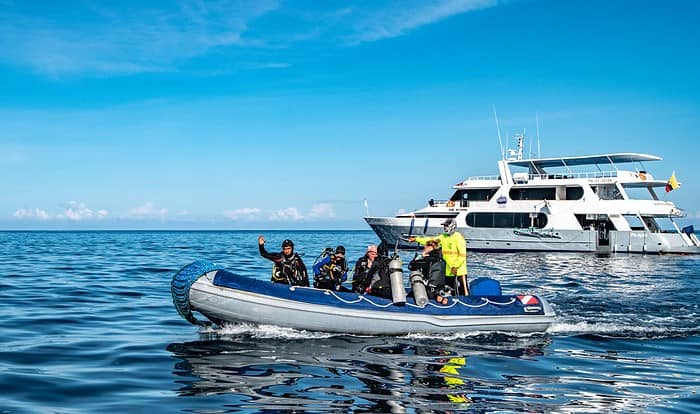
"Defined' get fix!" he hurries, and we don our masks, insert our regulator mouthpieces and check our photo kits one last fourth dimension.
It's an oxymoron really, having to apply thick rubber suits for a dive at latitude 0.0536 south; yes, half-of-a-caste southward of the equator! But we are diving the Galapagos Islands, a climate paradox due to geography, which straddles the globe'southward latitudinal centerline in the eastern Pacific Body of water, 1000Km from S America.
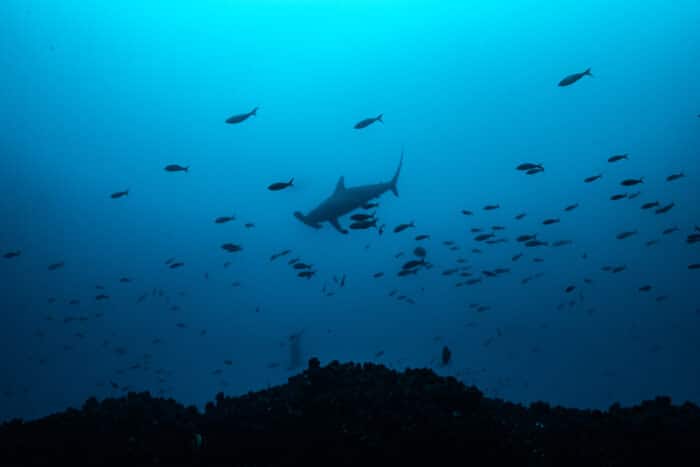
Logically, it's fair to reason that waters bathing the Galapagos archipelago should be bathtub-warm. Yet, due to its unique global placement, the Galapagos Islands are washed past three major and iv minor oceanic currents, which at times converge, diverge, mix, and layer, resulting in continuous water temperature contradictions. And this occurs throughout the islands; which is why we were ensconced in protective wearing apparel at Punta Vicente Roca.
"On the count of three!" Richard alerts, and, in unison, we roll into a warm, murky alkali at the end of his count.
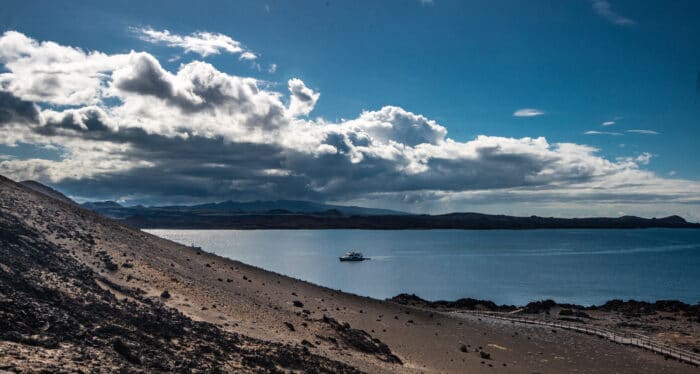
The oxymoron continues; at the surface, this site has little current. Seawater pools around the cove and warms considerably in the tropical sun. The result is a local micro-bloom of plankton in the nutrient-rich surface water, which contrasts with the cool water below an ever-nowadays thermocline past as much every bit 12C.
Collectively nosotros settle, piercing the murky soup at 15m, to a deep green, very clear, ethereal world. At the shimmering transition between warm and cool, the temperature instantly drops from 26C to 20C, with the visibility going from ane to +33m!
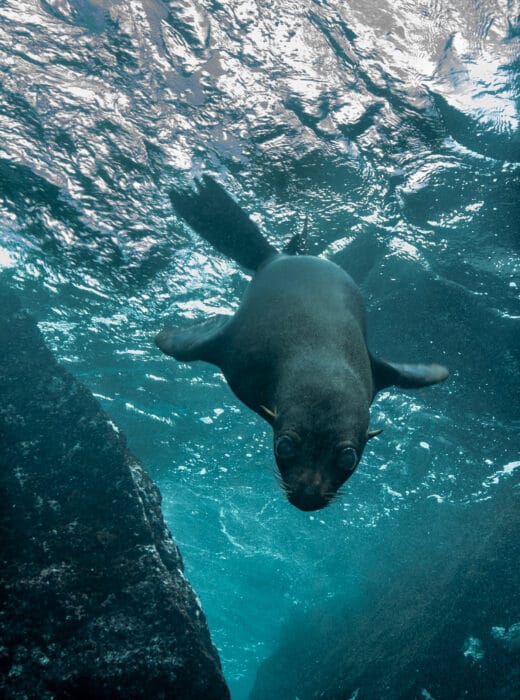
We glide the slope downwards, adjusting buoyancy, by spectacularly colored tapestries of bounding main fans, toward the white sandy bottom at nearly 35m. In the gloaming, a pair of juvenile Galapagos sea lions, ubiquitous on most dives in the Galapagos, rocket by the states from behind. Then, shooting up, they barrel-roll through our exhaust trails to the surface, their playful bulldoze-by apparently complete. At present, iii meters above the sandy floor, the water temperature has cooled to 17C, challenging our 7mm'south, in the otherworldly twilight.
All of a sudden, Richard bangs his tank with a metal clapper, snapping me from whiney thoughts well-nigh the cold. He signals our group to expect toward the deep. In the distance, a pair of mola mola materialize, sliding slowly toward our gob-smacked band of observers. It's a super-rare appearance, especially after Richard had proclaimed before the swoop that we would probable not run across mola mola, because it was "too warm."
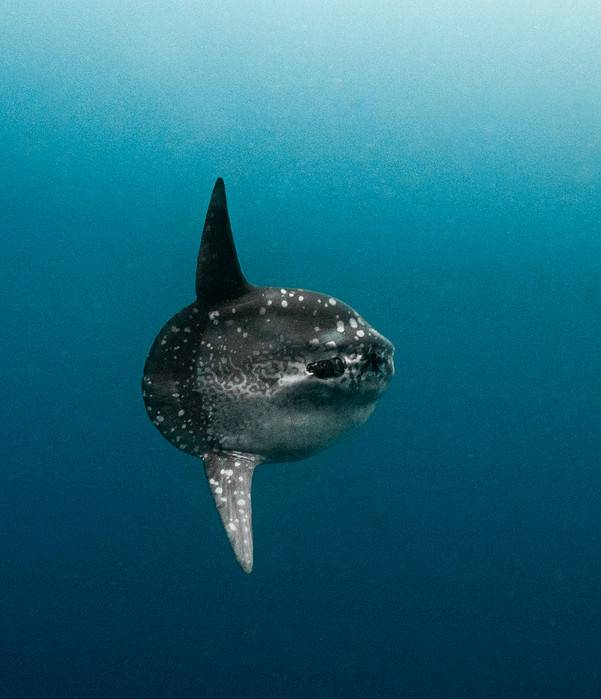
No longer thinking virtually the chill, I bank check my camera, hold my bubble exhaust and button with a single thrust toward the pb fish, trying to look pocket-sized and innocuous. While not a full-sized developed, this fish appears to span at to the lowest degree two meters between fin tips. I glide closer and the mola mola follows me with a large, curious center. I am, apparently, not a threat, but besides nothing of interest. The mola mola turns to the deep and slowly disappears with a gentle flutter of its giant dorsal and ventral fins. But only after I was able to click a unmarried image!
I turn back to the grouping where the wall meets the sandy airplane and sentry my fellow defined celebrate the uber-exceptional sighting with excited head bobs and fist pumps. In spite of Richard's prediction, or, maybe considering of Richard's prediction, we had a shut come across with an animate being I've never before witnessed in 40 years of diving!
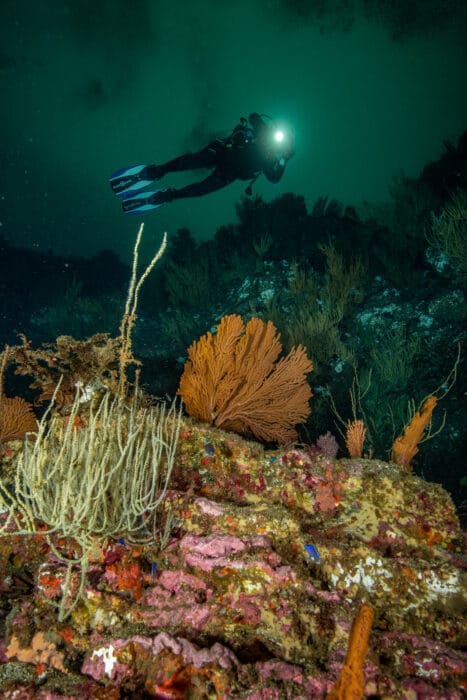
Fourth dimension is short and nosotros move to a valley of soft corals, across the sandy aeroplane, in search of elusive seahorses. Our practiced juju continues, Richard and one of our divers each find a cleverly inconspicuous seahorse amongst the softies.
Excitement abounds in the now refreshingly cool deep-sea as we shoot our images and search for other exotics before our swoop computers tick toward finality.
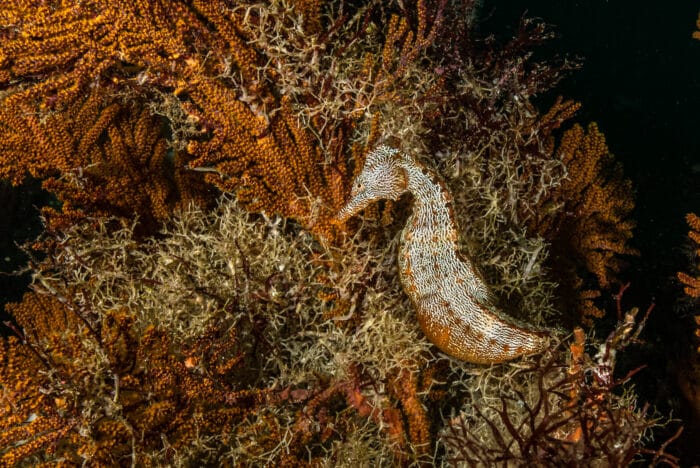
So it tin can go in the Galapagos Islands. A carnival of animate being oddities and rarities, both on land and sea, which attracts defined from around the world. So unique is the fauna, that one could nigh envision an early on, 20th-century carney barker loquaciously extolling the exotica.
"Ladies and Gentlemen…Footstep right Upwardly! Come up inside and be incredulous! Feast your eyes on a one-ton fish with no fins and no tail! Or marvel at the schooling sharks whose heads are shaped similar a coat hanger! Not impressed? How about a tortoise equally big as a clown car or a lizard that eats in the sea?"
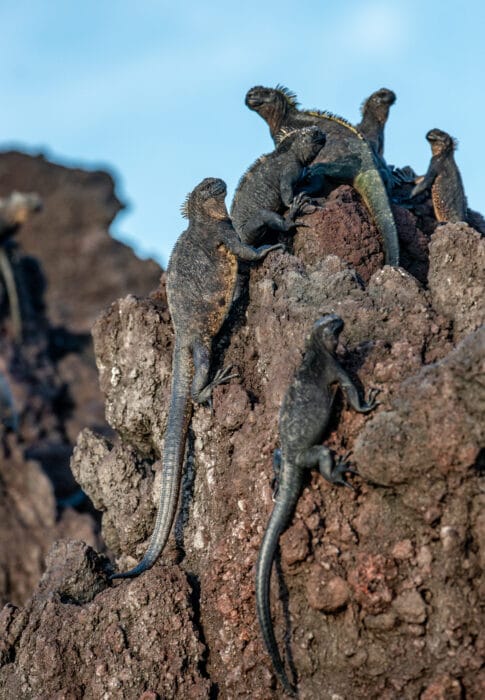
Indeed, the Galapagos Islands may well be the "greatest bear witness on earth." Since the fall of 1825 when Charles Darwin, aboard the British brig HMS Beagle, set pes in the Galapagos, explorers have acclaimed the wonders of these magnificent islands. Having been chosen "a unique living museum and a showcase of evolution" and, "a melting pot of marine species" by visiting naturalists, the Galapagos are a bucket list destination for many. Truly, it is this, which has brought me back to these remarkable islands for the 5th time in the terminal 15 years.
The Galapagos archipelago is comprised of 127 islands, islets, and rocks set between latitudes i.twoscore degrees North and 1.36 degrees Due south. Volcanic in origin, the islands are relatively young geologically, simply some five one thousand thousand years sometime, and, in the instance of Isla Isabela and Isla Fernandina, are withal actively forming. Indeed, every bit the GAII steamed toward Darwin Island on the second evening of our voyage, Wolf Volcano on Isabela was conspicuously visible spewing smoke, ash, and lava on its northern flank.
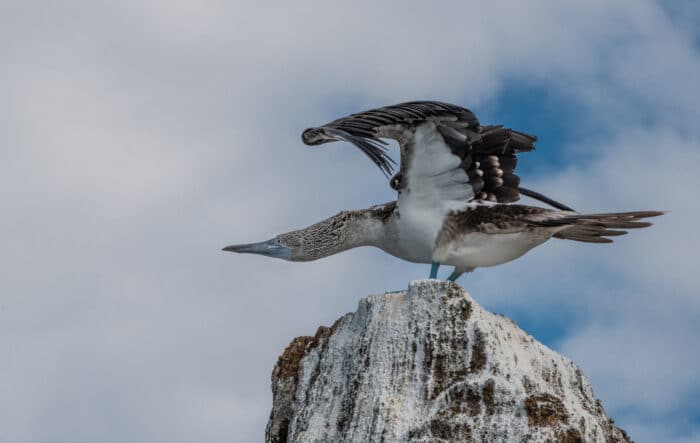
Information technology's the geographic location, isolation, and confluence of bounding main currents, taking the Galapagos' metaphorical "petri-dish of black volcanic rock," which has resulted in the speciation of 14 unlike land animals found nowhere else in the world. These animals include the Galapagos penguin, the Galapagos tortoise, the marine iguana, the blue-footed booby, the Galapagos flightless cormorant, and the Galapagos hawk.
Oceanwise, speciation is not quite as unique. Many resident species, such every bit the scalloped hammerhead shark, Galapagos shark, eagle ray, and green sea turtle are found elsewhere as ocean currents have brought circum-tropical and circum-temperate marine life to the islands more than easily. As such, the only apparent endemic species I could find in research is the green bounding main urchin, which were wonderfully abundant at Roca Blanca.

The carve up personality of water temperatures, coupled with unique state creatures, and side-show-like marine animals, all on the same voyage, invites an action-packed week for divers and underwater photographers. Where else can a diver notice tropical long-nose butterflyfish 1 day and temperate-loving mola mola on the next?
The northern islands of Wolf and Darwin were our first major destination on our week'south long voyage on the GAII. Located in a higher place the equator and washed by a relatively warm equatorial electric current (warm enough to back up stony corals), these islands are renowned for schooling scalloped hammerhead sharks, eagle rays, and the rare whale shark when currents are strong and unidirectional.
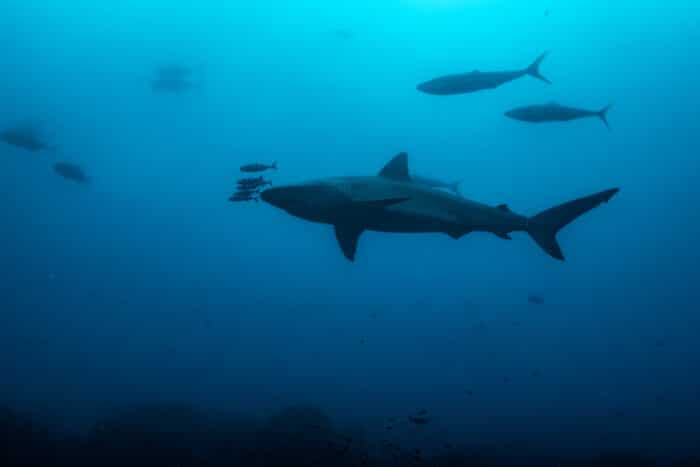
Oddly, during our visit, which coincided with the dorsum of the full moon, when tides should have been the strongest, the electric current(south) seemed confused, often pushing i way on the surface and the opposite management downwardly deep. As a result, the schooling sharks were a no-show. We did, however, witness many single shark drive-bys during our dives and were able to fully explore the reef surrounding Darwin'southward Columns (formerly Darwin'due south Arch) and Landslide Reef at Wolf.
The balmy, conflicted currents also gave the states an opportunity to shoot other locations (the Cave at Wolf Island) and lesser-acknowledged "side-show circus performers" on the reefs, including curious schools of hairdresser fish and sedate green bounding main turtles when our focus would have been otherwise directed (literally and figuratively) to the sharks.
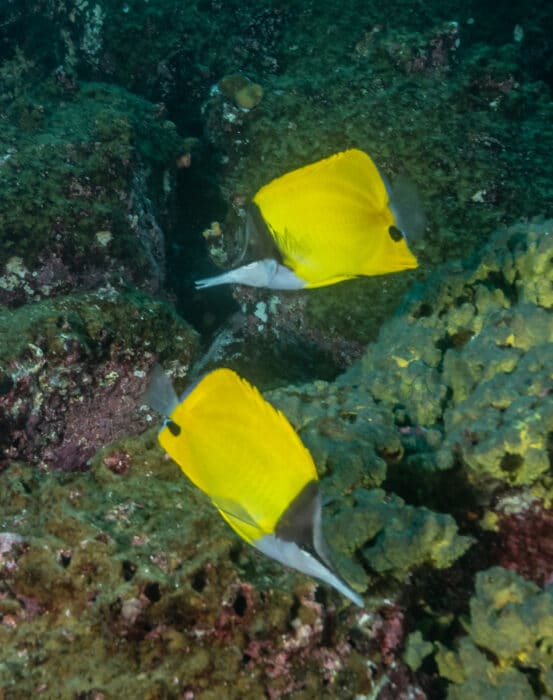
While the Galapagos' circus-center-ring performers were on hiatus in the northward, the Islands' side-show performers of the south picked upwardly the slack. At Greatcoat Douglas on Isla Fernandina, the marine iguanas were sun-fueled early on and entered the water at 10 AM to feed, giving our divers on the GAII a unique opportunity to notice yet another oxymoron of the archipelago; the cadger that eats in the sea.
By the hundreds, if not thousands, the charcoal-colored reptiles perch on the back volcanic rocks, if not each other, at Cape Douglas near oceans' border. There, they warm themselves sufficiently before venturing into the absurd Pacific to briefly feed on marine algae. Our funfair barker would accept been pleased, as we indeed marveled, incredulous, at this behavioral oddity.
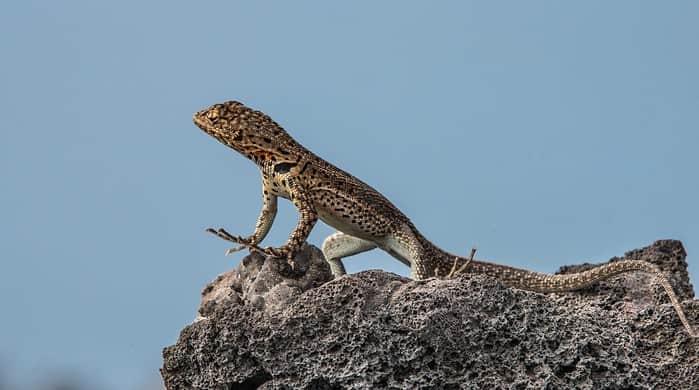
Farther along our voyage in the south, we encountered the omnipresent Galapagos Body of water Lions, whose playful antics drive a lensman mad. Like Whirling Dervish, the endemic pinnipeds' fluidity challenged my shooting on every level. While the juveniles are the most curious, young females volition oftentimes join in, eventually eliciting a response from the harem's dominant male.
As if to say, "alright, enough is enough!" the big male will run interference betwixt the divers and the females blowing a "alarm" frazzle trail of bubbles from his nostrils.
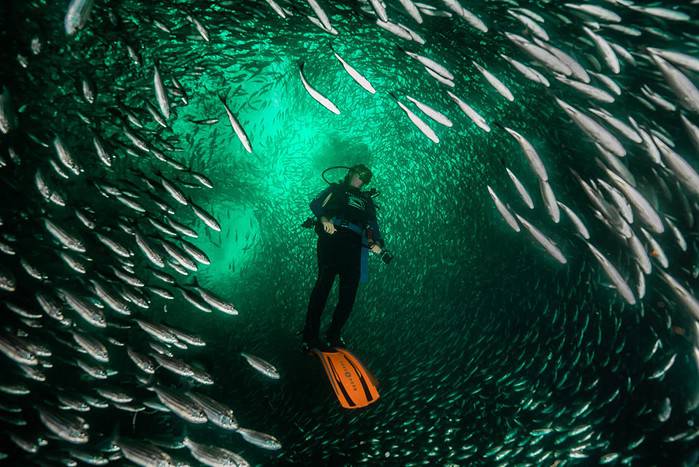
One afternoon at a relatively innocuous rock named Cowley, we encountered "the female parent of all" fish schools. The site is famous for its massive school of black-striped Salema. Thousands, if non millions of Salema shift shape incessantly from the surface to seafloor at Cowley. If it were not for the torch of our divemaster or the flicker of a strobe flash from my diving mates, I surely would have lost my style as the Salema turned day to night at 20m.
No trip to the Galapagos can be considered complete without a state safari or 2 to discover more of Charles Darwin'south natural selection superstars. The GAII gave us ii country excursions, plus a coastline prowl to find more animals endemic to Galapagos. At Isla Bartolome, nosotros climb the height (made famous in the Russell Crowe film, Master and Commander: The Far Side Of The World) where a Galapagos hawk, perched on a loftier rock, and a lava lizard, cooling its toes on a low rock, showcased a majestic overlook of the GAII in the passage below. At Pinnacle Rock we found bluish-footed booby, Galapagos penguin, and the Galapagos flightless cormorant, allowing image capture of yet more than Galapagos "A-listers."
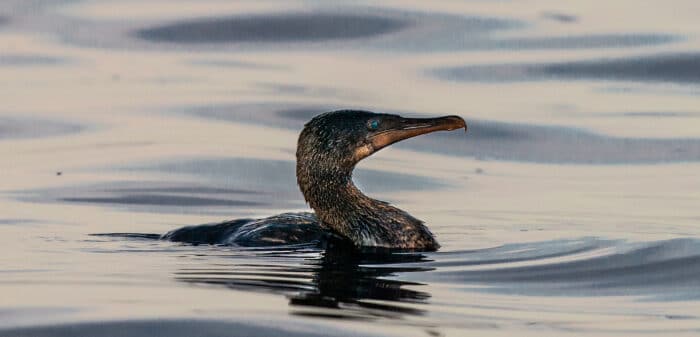
On our last afternoon, later the attentive GAII crew had washed our dive kits, we traveled upwardly-country to a farm on Isla Santa Cruz where we observed the terminal act of the circus, the globe's largest tortoise, in the wild. Our imaginary carnival barker would not accept been exaggerating for the estimated fourscore-yr-old tortoise would have rivaled the size of a small clown machine!
Every bit I expect back on the destinations I've explored over the years, I'g not surprised that the Galapagos has captured my time and involvement several times over. The Galapagos Islands are indeed a circus of the odd, ridiculous and grandiose. And similar the circus with requisite sideshows, it draws the curious, like a moth to a flame. This is why I'm already planning my sixth trip back to see, the greatest prove on world.
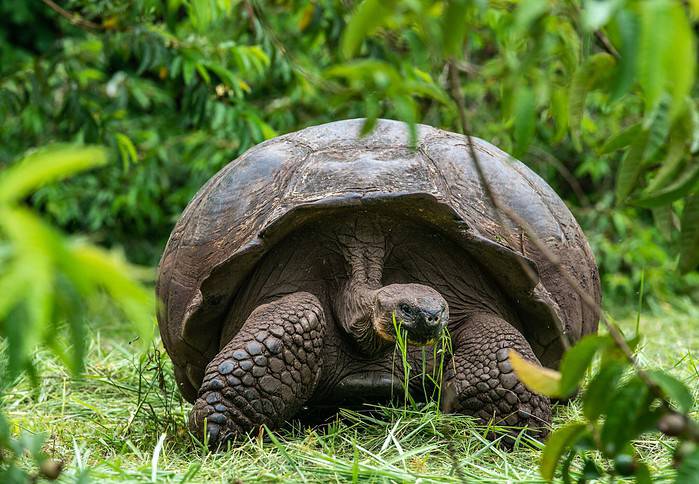
Other Helpful Data
Location
When to go
The Galapagos Islands tin be visited year around as the change between summer and winter months is minimal on the equator. Check with your Attacker trip planner while assessing the best fourth dimension to see certain species with a higher degree of regularity based on the month of the twelvemonth.
Getting there
All flights to the Galapagos Islands originate from either Quito or Guayaquil in Ecuador. Program on arriving in Ecuador the 24-hour interval earlier trip deviation. Direct flights to the Islands from either Quito or Guayaquil are available from two airlines, several time each day.
Choosing an take a chance itinerary
Visit www.aggressor.com
Other data
The travel planners at Aggressor will apprise yous of the latest travel requirements/restrictions based on the most current COVID-19 weather.
Article By Mark B. Hatter – Mark is a long-time outdoor photojournalist specializing in scuba diving photos and fly fishing essays and feature manufactures. Over the years Mark's images, comprehend shots, and stories, from every continent, have appeared in over 2 dozen dissimilar publication titles, including magazines, books, and manufacture advertising.
This is a sponsored post – for more than information please run into our disclosure policy.
Source: https://www.deeperblue.com/the-galapagos-islands-the-greatest-show-on-earth/
Posted by: robertsrabing.blogspot.com

0 Response to "What Animals Live On The Galapagos Islands"
Post a Comment